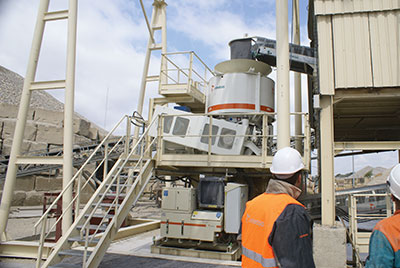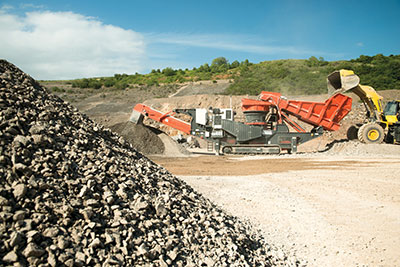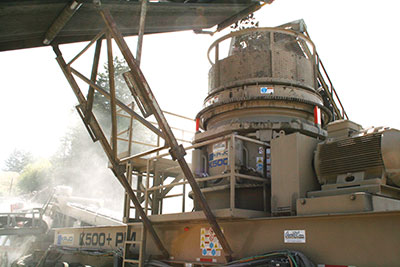
Features
Aggregates
Technology
Crushing Innovation
Cone crushing provides value for the quarrying industry
June 11, 2014 By Treena Hein
Cone crushers were valuable tools in the aggregate industry from the moment of their creation, and they remain so today.
Cone crushers were valuable tools in the aggregate industry from the moment of their creation, and they remain so today. It was in 1926 in North Hollywood, California, that the Symons Brothers invented the world’s first vertical cone crusher. “It revolutionized the crushing practice of the mining and quarrying industries,” says Carlos Padin, product manager at Metso for their HP (High Performance) Cone series. “All of the great ore and industrial mineral operations the world over became users of this very efficient machine.”

|
|
| The new Metso HP crushers are easy to maintain, with all components accessible from the top or side and an easily removable bowl and head.
|
While crushers and horizontal impactors each have a place in the market, cone crushers are favored for tougher materials, says Jeff Lininger, director of products and sales at KPI-JCI and Astec Mobile Screens’ manufacturing facility in Oregon. Ed Sauser agrees. “Compression crushers are popular for crushing hard, abrasive aggregates,” says the product manager at Terex Minerals Processing Systems.
Sauser adds, however, that the feed opening of cone crushers limits their use (except for very large static plant gyratory cone crushers) to a second or third stage crusher. Lininger is of the same mind, observing that they have indeed become the standard for secondary and tertiary crushing applications. “Their high reduction ratios, relatively low wear cost, ability to operate in a wide range of different materials, and favourable energy consumption make them one of the most commonly-applied rock crushers,” he says.
The higher capacity of a cone allows for using fewer or smaller units, adds Padin, and their compact size fits into all types of plants and is especially well suited for mobile applications. In addition, he says cone crushers help operators remain profitable by increasing usable end products, reducing downtime and maintenance costs. At the same time, they offer ease of automation and operation.
Sauser points to the built-in relief mechanisms on many modern cone crushers as a distinct advantage in their ability to allow tramp iron, like loader bucket teeth, to pass through with little or no damage. “Tramp iron usually causes significant damage and downtime to impact-style crushers,” he explains. The flexibility of cone crushers is also valued by industry. “Particle size is highly controllable with the ability to set specific clearances between cone crusher liners,” explains Sauser. Lininger adds that these crushers are more effective producing products less than 25mm.
Over the decades
In Metso’s cone crushers, advancements began when Nordberg Manufacturing Company (Metso’s predecessor) acquired the Symons cone crusher business in 1928. “Among the early improvements was the development of a hydraulic cone crusher, which can expel the uncrushable materials that entered into the crushing cavity and can adjust the discharging size during operation,” says Padin, “producing end products with a uniform size.” Today’s cone crushers produce 20 to 40 per cent more throughput for a given size than what was offered 20 or so years prior, says Lininger. “The output gradation is tighter and the product is more cubical,” he notes.

|
|
| The newest Sandvik models also offer longer liner life, higher reduction values, better use of energy, and constant production throughout the majority of the liner life cycle.
|
Cone crushers are also now able to be used in more applications than in the past. “For instance, it used to be common for a VSI (vertical shaft impactor) to be used in a tertiary stage of crushing,” explains Lininger. “This was due to the particle shape and percentage of fines that were required in many of today’s product specifications…Cones are now able to replace VSIs and will produce a superior product, with the cubicity required but without the excess fines often found in a product when using an impact crusher.”
Lininger adds that different sets of liners allow some of his customers to produce a manufactured sand in one pit, and to feed their cone 11” material in another. “What used to require a specialized tool like a gyrasphere that produced manufactured sand in low tonnages, or an impact crusher that produced manufactured sand but at a high wear cost, can now be accomplished using our cone Kodiak Plus Cone Crusher, with the right choice of liners and the knowledge of how to do it.”
Today’s higher-capacity cone crushers have gained usage in producing low abrasive aggregates, adds Sauser. “Other design improvements that speed up crusher setting changes and faster crusher opening/separation for clearing blockages as well as wear liner change have made them more desirable,” he explains.
New offerings
Today’s Metso cone crushers are built on company experience with both Symons cones and Omnicone. Metso first introduced the Nordberg HP (High Performance) Series cone crushers in 1990, combining the best features both. “With a combination of optimized speed and large throw, HP new generation provides the highest reduction ratios of any current cone crusher,” says Padin. “Due to their super-efficient crushing action, the HP3, HP4 and HP6 have the best power utilization per cone diameter. So you save twice with lower kWh per ton of crushed end product and with lower recirculation load. Higher cavity density improves crushing action for end products with more consistent gradation and superior shape.”

|
|
| The cone crushing chamber of the Kodiak Plus is able to offer high throughput and strong output quality through a unique combination of head angle, crusher throw and speed.
|
The new Metso HP crushers are also easy to maintain, with all components accessible from the top or side and an easily removable bowl and head. “An advanced fastening system for the mantle and bowl liner makes backing material unnecessary,” Padin adds, “and makes liner changes faster.”
The new Terex Cedarapids MVP380X and MVP450X cone crushers boast numerous features that increase their productivity and ease of use. “The 300 hp (224 kW) MVP380X and 400 hp (298 kW) MVP450X incorporate pinned cylinder ends that remove quickly to allow fast cone separation which results in faster manganese changes, reducing downtime,” says Sauser. “At the press of a button, fully-guided, dual-action tramp relief cylinders provide 6” (152 mm) lift for easy clearing of jammed feed material.”
The hydro-pneumatic tramp iron relief system instantly resets the crusher setting after passing uncrushable material, without having to activate valves and pumps. In addition, a high-flow manifold system with four accumulators provides redundant cylinder protection. “The hydraulic-powered threaded upper assembly allows for quick crusher setting adjustment under load,” Sauser adds. “Computer-optimized mainframe components are high endurance, all-cast construction.” The new, more rugged cone heads are designed for high-force, demanding crushing applications. “Rollercone” patented super bearing design provides higher efficiency, making more horsepower available for crushing.
The newest Sandvik mobile cones are the S range, models QS441 and QS331. “Our cone technology has evolved by offering models that are epoxy backing-free in some instances,” says Virginia Varela-Eyre, Sandvik ‘Americas’ marketing manager. The newest Sandvik models also offer longer liner life, higher reduction values, better use of energy, constant production throughout the majority of the liner life cycle, and extended oil change frequency.
The cone crushing chamber of the Kodiak Plus (KPI-JCI and Astec Mobile Screens) is able to offer high throughput and excellent output quality through a unique combination of head angle, crusher throw and speed. Lininger says the design changes came from customer requests for high throughput in less-than-ideal situations. “That’s what most producers face on a routine basis,” he notes. “Producers face issues like changing feed dimensions to the crushers, wet material, plastics in the feed material, unevenly worn liners, finishing out an improper liner section from the last job, and tough material conditions, such as harder materials or narrow feed gradations.” Lininger says the Kodiak Plus is the application-friendly cone crusher the industry needs, with a patented bowl liner retention system that simplifies liner changes and a control system allows for remote operation and monitoring.
Print this page